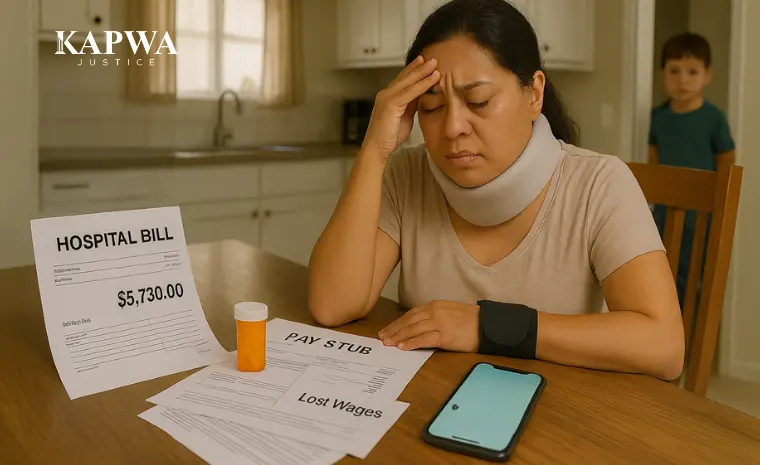Table of Contents
Summary
Pain and suffering damages compensate injured accident victims for emotional and physical hardships after a car accident in California. This blog explains what counts as pain and suffering, when you can file a claim, how compensation is calculated, and why hiring California personal injury lawyers strengthens your case.
Recovering from a car accident in California is not just about repairing vehicles or paying medical bills. Many injured accident victims also face lasting emotional and physical pain that disrupts daily life. These hardships, legally known as pain and suffering, can be included in personal injury claims.
Understanding your rights and the process is essential. This article explains what qualifies as pain and suffering, how damages are determined, and the steps to strengthen your claim.
Let’s explore the main factors that affect personal injury cases.
What Counts as Pain and Suffering?

Pain and suffering are the non-economic damages an injured person endures after a crash. While medical care covers physical recovery, pain and suffering focus on the unseen impact.
Examples include:
- Emotional distress such as anxiety, depression, or PTSD.
- Physical discomfort from internal injuries or Catastrophic Injuries.
- Loss of enjoyment of life due to long-term conditions like a brain injury.
- Disruption of personal relationships and quality of life.
Both car and pedestrian accidents can qualify for these claims and cases involving slip and fall accidents.
When Can You File a Claim in California?
Under California law, you may include pain and suffering in a personal injury claim if:
- Another party’s negligence caused the crash (motor vehicle accidents, auto accident, or other).
- You suffered measurable harm beyond property damage.
- Medical treatment and medical records confirm your condition.
⚖️ Important: The statute of limitations in California generally gives you two years from the date of the crash to file a lawsuit. Kung hindi ka makapag-file on time, mawawala ang chance mong makakuha ng damages.
How Is Pain and Suffering Calculated?
Unlike economic damages such as lost wages or medical bills, pain and suffering has no exact dollar amount. Courts, insurance companies, and insurance adjusters often use two methods:
- Multiplier Method – Depending on severity, economic damages are multiplied by a number (usually 1.5–5).
- Per Diem Method – A daily rate is applied for every day of suffering until recovery.
Factors that influence the calculation:
- Severity of injuries (from minor trauma to catastrophic injuries).
- Duration of recovery time and long-term impacts.
- The credibility of medical records and expert testimony.
Evidence to Strengthen Your Claim
Strong evidence is key to proving pain and suffering in personal injury cases. Here’s what can help:
- Medical records documenting diagnoses, treatments, and progress.
- Expert testimony from doctors, therapists, or specialists.
- Personal journals describing daily struggles and limitations.
- Photos or videos showing physical injuries or reduced quality of life.
- Witness statements from family, friends, or coworkers.
📌 Pro Tip: Keep all documents related to your injuries and never miss medical treatment or appointments, as gaps in care can weaken your personal injury claim. Insurance company representatives might dispute claims without solid proof.
Legal Guidance: Your Key to Maximum Compensation
Insurance companies may attempt to downplay pain and suffering or use Insurance bad faith tactics to minimize payouts. Having experienced California personal injury lawyers on your side ensures fair treatment.
A skilled legal team can:
- Investigate motor vehicle accidents thoroughly.
- Negotiate with insurance adjusters and file lawsuits if necessary.
- Pursue maximum compensation for both economic damages and non-economic damages.
- Work on a contingency fee basis, meaning no upfront costs.
Personal injury lawyers also know how to handle complex cases involving auto accident injuries, slip-and-fall accidents, and pedestrian accidents.
The Support You Need, When You Need It Most
Pain and suffering damages provide essential relief for injured accident victims after a car accident in California. From emotional trauma to long-term health complications, these damages recognize hardships beyond financial losses. You can protect your rights and pursue justice with strong evidence, proper medical treatment, and support from California personal injury lawyers.
📞 Call our legal team today for a free consultation. Isang tawag lang, makukuha mo na ang gabay na kailangan mo.
FAQs
Can I claim pain and suffering after a minor car accident?
Yes, even minor accidents may qualify if you experience ongoing pain, stress, or disruption to daily life.
Do I need medical treatment to file for pain and suffering?
Yes. Medical records are essential to support your personal injury claim. Without documented medical treatment, it becomes harder to prove the extent of your suffering to insurance companies or the court.
How much time do I have to file a claim in California?
Generally, you have two years under the statute of limitations. If your claim involves a government entity, you may have as little as six months to file a notice of claim.
Can pain and suffering be claimed for non-physical injuries?
Yes, emotional trauma like anxiety or depression may qualify. These non-physical effects are recognized as non-economic damages and can significantly impact your quality of life.
What if insurance companies deny my claim?
Your legal team can challenge the insurance provider for fair compensation or pursue litigation.




